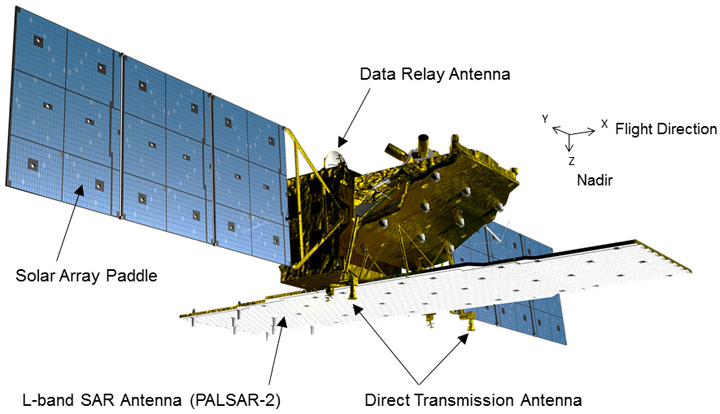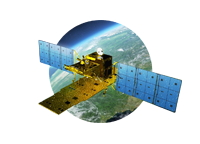The Advanced Land Observing Satellite-2 (ALOS-2, "DAICHI-2") is a follow-on mission from the ALOS "Daichi". ALOS has contributed to cartography, regional observation, disaster monitoring, and resource surveys, since its launch in 2006. ALOS-2 will succeed this mission with enhanced capabilities.
JAXA conducted research and development activities for ALOS-2 to improve wide and high-resolution observation technologies developed for ALOS in order to further fulfill social needs. These social needs include: 1) Disaster monitoring of damage areas, both in considerable detail, and when these areas may be large 2) Continuous updating of data archives related to national land and infrastructure information 3) Effective monitoring of cultivated areas 4) Global monitoring of tropical rain forests to identify carbon sinks.
The state-of-the-art L-band Synthetic Aperture Radar (PALSAR-2) aboard ALOS-2 will have enhanced performance compared to ALOS/PALSAR. The PALSAR-2 is capable of observing day and night, and in all weather conditions.
The ALOS-2 was launched by the H-IIA Launch Vehicle on May 24, 2014.

| Orbit | Type | Sun-synchronous sub-recurrent orbit |
|---|---|---|
| Altitude | 628km above the equator | |
| Inclination angle | 97.9° | |
| Local sun time | 12:00±15min at descending node | |
| Revisit cycle | 14 days | |
| Shape | 3.5m×3.2m×4.5m (Launch Configuration) 16.5m×3.7m×9.9m (On-orbit Configuration) |
|
| Mass | Approx. 2100kg | |
| Life time | 5years (target: 7years) | |
| Power | Generated power | Approx. 5300W (EOL) |
| Battery | Li-ion battery: 200Ah | |
| Duty ratio | 50% (49min.) | |
| Mission data downlink | Direct transmission (max. 800Mbps) or via Data Relay Satellite (278Mbps) |
|
| Data recorder | 128GByte (EOL) | |
| Mission instruments | L-band Synthetic Aperture Radar (PALSAR-2) | |
| Launch | Launch date | May 24, 2014 |
| Launch vehicle | H-ⅡA launch vehicle #24 | |










